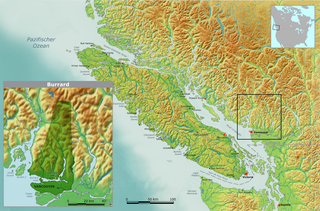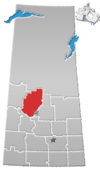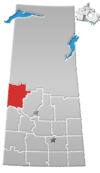Related Research Articles

The Muskoday First Nation is a First Nation band government in Saskatchewan, Canada, composed of Cree and Saulteaux peoples. The First Nation has a registered population of 1,828 people as of September 2014, of which approximately 623 members of the First Nation live on-reserve, and approximately 1204 live off-reserve. Muskoday's territory is located in the aspen parkland biome. It is bordered by the rural municipalities of Birch Hills No. 460 and Prince Albert No. 461.

The Tsleil-Waututh Nation, formerly known as the Burrard Indian Band or Burrard Inlet Indian Band, is a First Nations band government in the Canadian province of British Columbia. The Tsleil-Waututh Nation ("TWN") are Coast Salish peoples who speak hən̓q̓əmin̓əm̓, the Downriver dialect of the Halkomelem language, and are closely related to but politically and culturally separate from the nearby nations of the Sḵwx̱wú7mesh (Squamish) and xʷməθkʷəy̓əm (Musqueam), with whose traditional territories some claims overlap.
Yellow Quill First Nation (formerly Nut Lake Band of Saulteaux) is a Saulteaux First Nation band government in Saskatchewan, Canada. Their reserve is twenty kilometres northwest of Kelvington. The Yellow Quill First Nation is a signatory of Treaty No. 4, which was signed by Chief Yellow-quill on August 24, 1876.

Treaty 4 is a treaty established between Queen Victoria and the Cree and Saulteaux First Nation band governments. The area covered by Treaty 4 represents most of current day southern Saskatchewan, plus small portions of what are today western Manitoba and southeastern Alberta. This treaty is also called the Qu'Appelle Treaty, as its first signings were conducted at Fort Qu'Appelle, North-West Territories, on 15 September 1874. Additional signings or adhesions continued until September 1877. This treaty is the only indigenous treaty in Canada that has a corresponding indigenous interpretation.
Buffalo Point First Nation is an Ojibwa or Saulteaux First Nations located in the southeastern corner of Manitoba, along the shores of Lake of the Woods. It is bordered largely by the unorganized portion of Division No. 1, Manitoba, and also has smaller borders with the Rural Municipality of Piney, as well as the northeast corner of Roseau County, Minnesota.
Nigigoonsiminikaaning First Nation, formerly known as the Nicickousemenecaning First Nation and as the Red Gut First Nation, is a Saulteaux First Nation band government who inhabit the banks of Rainy Lake of the Rainy River District in Northwestern Ontario, Canada. As of January, 2008, the First Nation had a population of 290 registered people. As of 2017, it has approximately 130 on-reserve members.
Wabigoon Lake Ojibway Nation, commonly known as Wabigoon First Nation, is a Saulteaux First Nation band government who inhabit the Kenora District in northwestern Ontario, Canada. It is approximately 19 km southeast of Dryden, Ontario. As of January 2008, the First Nation had a registered population of 533 people, of which their on-Reserve population was 175.
Lac La Croix First Nation is a Saulteaux First Nation band government who reside in the Rainy River District of northwestern Ontario, Canada, along the Ontario-Minnesota border. It is approximately 200 km northwest of Thunder Bay, Ontario. As of January 2008, the First Nation had a registered population of 398 people, of which their on-Reserve population was 273.
Wabaseemoong Independent Nations or more fully as the Wabaseemoong Independent Nations of One Man Lake, Swan Lake and Whitedog, is an Ojibway First Nation band government who reside 120 km northwest of Kenora, Ontario and 13 kilometres (8.1 mi) east of the Ontario-Manitoba border of northwestern Ontario, Canada. As of December 2018, the First Nation had a population of 2,000 registered people, of which their on-Reserve population was 1200 registered members and approximately 100 non-Band members.
Skownan First Nation is a Saulteaux (Ojibwe) First Nations band government whose reserve community, Waterhen 45, is located 288 km north of Winnipeg, Manitoba, Canada, on the south shore of Waterhen Lake, between Lake Winnipeg and Lake Winnipegosis. As of May, 2015, the First Nation had 1,464 registered members, of which 750 lived on-reserve.
Muskowekwan First Nation is a Saulteaux (Ojibway) First Nation who inhabit approximately 100 km northwest of Melville, Saskatchewan, Canada. As of May, 2008, the First Nation has 1,517 registered people, of which their on-reserve population was 400.
Brunswick House First Nation is an Ojibway-Cree First Nations in the Canadian province of Ontario, located in the Sudbury District, 157 km (97.6 mi) northeast of Sault Ste Marie, Ontario. The First Nation have reserved for themselves the 9,054.2 hectares Mountbatten 76A Indian Reserve and the 259.8 hectares Duck Lake 76B Indian Reserve. As of June, 2008, it had a registered population of 639 people, of which their on-Reserve population was 171 people.
Fishing Lake First Nation is a First Nation of the Saulteaux branch of the Ojibwe nation. Fishing Lake First Nation are Anishinabek people. The band can trace their origins to central Canada, and were pushed westward to avoid encroachment by European settlers. The First Nation was originally part of the Yellow-quill Saulteaux Band, a Treaty Band named after a Treaty 4 signatory Chief Ošāwaškokwanēpi, whose name means "Green/Blue-quill." However, due to "š" merging with "s" in Nakawēmowin, this led to a mistranslation of his name as "Yellow-quill"—"yellow" being osāw-, while "green/blue" being ošāwaško-. The band was given three reserves, at Fishing and Nut Lakes and Kinistino, Saskatchewan. The Fishing Lake Indian Reserve 89 was approximately 22,850 acres (92.5 km2). Soon after the death of Chief Ošāwaškokwanēpi, the Band divided into three groups, the Fishing Lake First Nation, the Yellow Quill First Nation, and the Kinistin Saulteaux Nation

The Kinistin Saulteaux Nation is a Saulteaux band government in Saskatchewan. Their reserve is 39 kilometres (24 mi) southeast of Melfort. The Kinistin Saulteaux Nation is a signatory of Treaty No. 4, which was signed by Chief Yellow-quill on August 24, 1876.

Seine River First Nation, previously known as the Rivière la Seine Band, is an Ojibwe First Nation reserve located roughly 300 kilometres (190 mi) west of Thunder Bay, Ontario. As of November 2011, the First Nation had a total registered population of 725, of which 327 lived on their own reserve.
Rainy River First Nations is an Ojibwe First Nation band government in Emo, Ontario, Canada.

The Cote First Nation is a Saulteaux First Nations band government in Kamsack, Saskatchewan. This Saulteaux reserve is connected to the Keeseekoose First Nation and only a couple of miles from the Key First Nation. Their land is situated just south of the boreal forest in the aspen parkland ecosystem of Canada. The Ojibwe of this region of Saskatchewan and Manitoba were both hunters of the plains bison and hunters of the forests which were more abundant during the 19th century. They also fished the endless lakes and other waterways in the land. They seldom went hungry as a result of the large bison herds. However, by the 1870s, commercial hunting had reduced the bison to near extinction and the Ojibwe of Saskatchewan and Manitoba began to suffer from famine.
The Keeseekoose First Nation is a Saulteaux band government located in Kamsack, Saskatchewan. The band is named for Chief Kiishikouse, who signed an adhesion to Treaty 4 at Swan Lake, Manitoba in 1875. Flooding on the band's Manitoba reserve forced a relocation to the band's current location, adjacent to the Cote First Nation reserve. Those who stayed in Manitoba are today known as the Pine Creek First Nation. The current population is approximately 2750 people, with the majority living abroad and in urban centers across Canada.
Big Grassy First Nation is an Ojibwe or Ontario Saulteaux First Nation band government located in Rainy River District, Ontario near Morson, Ontario.
Ojibways of Onigaming First Nation is an Ojibwe or Ontario Saulteaux First Nation located in Kenora District, Ontario near Nestor Falls, Ontario. Together with the Big Grassy First Nation, Ojibways of Onigaming First Nation is a successor apparent to the former Assabaska Band of Saulteaux. Total registered population in February, 2012, was 737, of which the on-reserve population was 445. The First Nation is a member of the Anishinabeg of Kabapikotawangag Resource Council, a regional tribal council that is a member of the Grand Council of Treaty 3.
References
- ↑ "First Nation Detail - Saulteaux". Crown–Indigenous Relations and Northern Affairs Canada . Government of Canada. Retrieved 1 December 2018.

